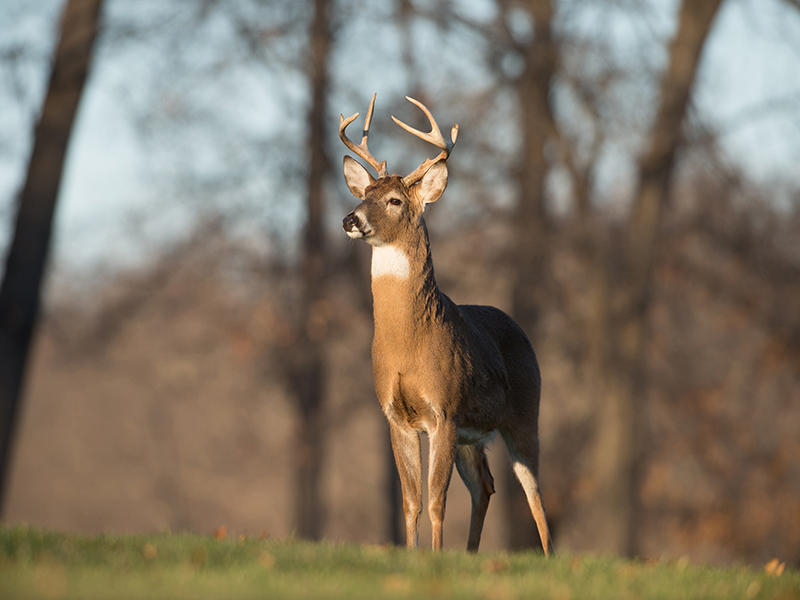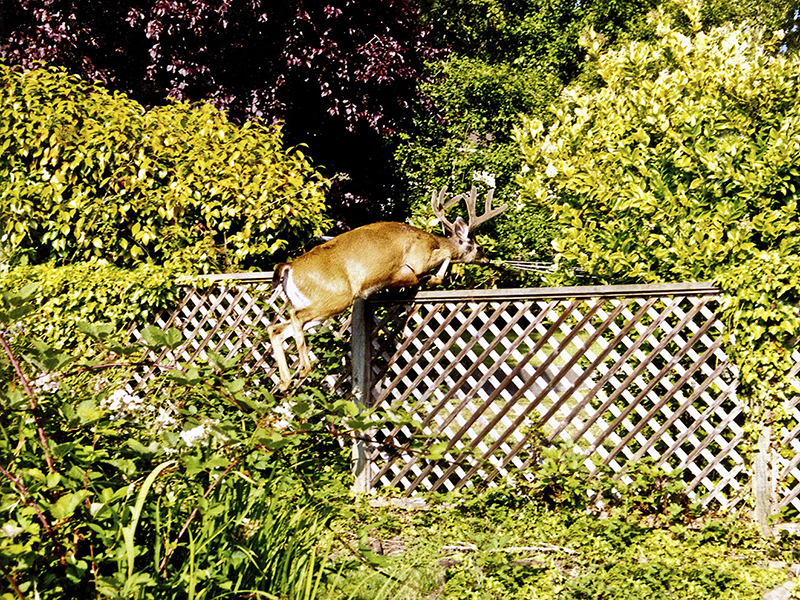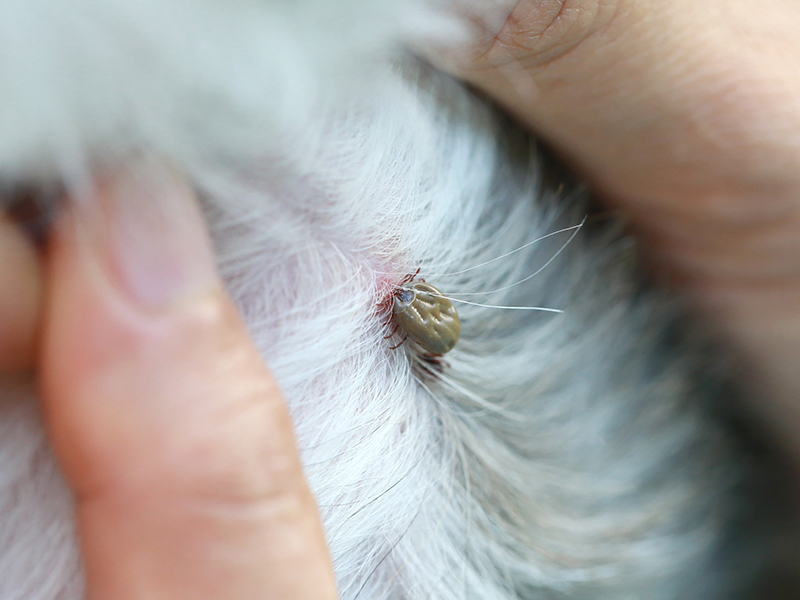what causes deer to loose hair on their face and looks purplish
White-Tailed Deer (Odocoileus virginianus)

A male white-tailed deer, likewise known every bit a buck
Introduction
New York City attracts people from all over the globe. Having them all in 1 place is neat for exchanging ideas, experiencing new cultures, and fifty-fifty only people-watching. The drawback, of course, are the crowds. As anyone who has been stuck in metropolis traffic or crammed into a crowded subway auto tin can tell you, overcrowding presents challenges. This is truthful of white-tailed deer (Odocoileus virginianus) likewise. White-tailed deer are a part of New York Land'south rich ecosystems and are greatly valued by many New Yorkers. Nevertheless, at loftier population levels deer can pose significant challenges to human being health and safety through deer-vehicle collisions and associations with tick-borne illnesses. They are too a serious threat to woods health, and can impact other native wildlife that depend on this habitat. Within New York Metropolis, there are populations of white-tailed deer in the Bronx and on Staten Isle. Just similar New Yorkers, deer prefer to live in areas with lots of food options and plenty of space. That's what makes the abundance of greenery and shelter found in these boroughs' parks and greenspaces so attractive. Without agile management, deer populations are expected to increase and farther exploit available habitats. The City has implemented an integrated, non-lethal, site-specific management plan that will allow experts to take immediate steps to reduce futurity impacts of an over-arable deer population, which you tin can read near by clicking hither.
Directory
General Information
- Groundwork
- Appearance
- Behavior
Deer Touch on Management Plan
- Overview
Education & Prophylactic
- Drivers
- Homeowners
- Garden Care
- Pet Owners
- Ticks and Lyme Disease
Fast Facts and Coexistence Tips
- Fast Facts
- Coexistence Tips
Males brainstorm to abound antlers when they are about a year one-time. In tardily January to March, bucks shed their antlers, and they regrow them in the spring to summertime, developing larger sets with age. Antlers abound out of bony plates on the top of their head. During leap and summer, their antlers are covered in fine velvet-like pilus. This velvet is full of blood vessels that send nutrients for rapid antler growth. Past the end of September, the antlers reach their maximum size, harden, and the outer velvet begins to shed. Bucks often rub against trees to assist in shedding, exposing the rigid bony antler. In the winter, bucks shed their antlers. If you run across a buck with what looks like bloody spots on the top of its head, don't be alarmed; he has just shed his antlers. During the rut, bucks use their antlers to found their dominance and win mates. Bucks with larger antlers and body size tend to be more aggressive and more than successful during the breeding flavor. Bloodshed caused by disease, sparring, hunting, and vehicular collisions brings the average age of deer to v years, though they have been known to live as long equally 14 years. Their large size as well means that white-tailed deer crave lots of food. Fortunately for them, they have plenty of repast options. Their four-chambered stomachs are able to process different vegetation depending on what'southward available. Deer browse on leaves, flowers, berries, grasses, acorns, other nuts, fungi, twigs, and bark. They primarily eat during twilight hours in the leap and during daylight hours in the summer. Winter foraging commonly takes identify in tardily afternoon. However, they can exist seen at any fourth dimension during the day. At high population levels, deer browsing causes significant damage to local found life. Deer have too been known to snack on plants in gardens. To learn more than almost how homeowners can protect their gardens from white-tailed deer, click here. Back to Top The Metropolis of New York has adult a five-pronged Deer Impact Management Plan to gainsay the negative impacts of the overabundant deer population on Staten Island. The plan includes: Back to Summit The Urban center is enlightened of a greater potential for crashes involving deer on Staten Isle and in the Bronx. We are taking steps to ensure sensation nigh potential conflicts between drivers and wild animals such every bit installing deer corridor signage. • Activity peaks in the fall breeding flavour, only deer can be a safety hazard on the road all year long.• Use caution when driving at dawn or sunset, when deer are most active.• Deer spend much of their time in parks and greenspaces. Be extra warning when driving well-nigh or through these areas.• Deer sometimes travel in family groups, and seeing ane animal could mean others will follow.• Deer practise unpredictable things — they may finish in the middle of the road, cross back and forth quickly, or motility toward budgeted vehicles. • The most of import thing you can practice to avert a collision with wildlife is to slow downwards. Drive the posted speed limit, and even slower in areas with known deer populations.• Scan the road and shoulders alee. Look for reflections, shadows, and movements that betoken wild animals action.• Use your headlights to ameliorate visibility.• Always wear a seat chugalug to minimize injury should a collision occur. Avoid distracted, drowsy, or impaired driving. • If a deer runs in front of your vehicle, brake firmly only exercise not swerve. Swerving can take a motorist into oncoming traffic or off the road.• Call 911 in the event of a collision.• If you strike a deer, do not touch or get close to it. The animal may be injured and could acquit aimlessly, causing further rubber risks. White-tailed deer are herbivores, which ways they consume plants. Sometimes, the plants in a homeowner'south garden are more appealing to deer than the plants in nearby natural areas. Leaving food like corn and breadstuff outside volition not stop deer from eating your garden plants. In fact, it will further attract them to the area, and make them more probable to damage your garden. Feeding deer is also illegal. At that place are no plant species that are truly "deer-proof." If white-tailed deer are hungry enough they will eat almost anything, even the bark from copse. While plant harm cannot be totally prevented, deer practice develop preferences. In that location are many types of plants bachelor which deer prefer less than other plants. The plants recommended below are bonny and accept the added benefit of being native to the region and so they contribute to the health of beneficial native wildlife, similar pollinators, and the ecosystem in general. Most of these plants can be establish at local nurseries and gardening stores, or online. Planting with a high diversity of native found species volition minimize the impact that any browse will have on your overall garden design. • Butterfly weed (Asclepias tuberosa) • Spice bush (Lindera benzoin) Click here to learn more about plant species to the lowest degree-preferred by white-tailed deer. Your companion animals are more probable to be interested in deer than vice versa, but information technology's better for all that they go on their distance from 1 another. Deer are big, potent animals and can severely hurt or kill a pet if attempting to defend themselves. Additionally, an animal allowed to chase deer may cease upwardly running into traffic, not only putting the animals in danger but potentially people likewise. Follow these steps for all members of your family—iv-legged and two-legged akin—to co-exist peacefully with deer: • Keep pets abroad from any injured or deceased deer besides as live animals. Carcasses can transmit disease.• Lyme disease is the well-nigh common tick-borne infection in New York City and the Usa. White-tailed deer cannot transmit Lyme affliction. Notwithstanding, when ticks infected with the disease latch onto deer, the deer tin acquit the ticks long distances and assistance the disease spread to new areas. Lyme disease is transmitted to humans from blacklegged ticks, as well known as deer ticks. Not all blacklegged ticks comport Lyme disease, and one time a person is bitten the tick must remain attached for at least 24-36 hours in order to transmit the disease. Lyme disease can cause symptoms like fever, headache, fatigue, and rashes on the peel. If left untreated, Lyme disease can cause serious complications. To foreclose tick bites and reduce the run a risk of contracting Lyme disease: Back to Top • In New York City, white-tailed deer tin can currently be found in the Bronx and Staten Island.• Male deer are called bucks. Adult bucks grow and shed antlers annually. Bucks are more active in the fall (October–December) because of mating season. They are much more likely to be striking by motor vehicles during this time.• Female deer are chosen does. Does requite birth to i-iii fawns in late spring (May–June).• Deer can stitch to 35 miles per hour and swim.• Deer eat a diverseness of plants, fruits, and leaves; overgrazing can alter forest limerick, assuasive invasive species to flourish and threatening the future sustainability of forests.• All wild animals in New York State falls under the regulatory jurisdiction of the State Section of Ecology Conservation.• Information technology is illegal to hunt anywhere in New York Urban center. General Data
Groundwork
White-tailed deer can be found throughout North America, with the exception of some areas in the southwest. They prefer wooded areas for protection and bedding, close to food and h2o. These resources are what concenter deer to parks and greenspaces in urban areas like New York City. Like most urban wildlife, white-tailed deer are extremely adjustable. They tin can exist found in forests, grassland, farmland, and transition zones or edge habitats. Most white-tailed deer have home ranges that are most one foursquare mile throughout the year. Males will often travel farther during mating season. White-tailed deer are generally considered solitary, specially in summer. Yet, does are often seen with their fawns and sometimes graze together in groups.
Appearance
White-tailed deer are large mammals. Adult deer can measure out between 31 and twoscore inches tall at the shoulder, and counterbalance up to 300 pounds. Their glaze is a reddish-dark-brown during summertime, and a duller grayish-brown during winter months. Their throats, inner ears, underparts, and the underside of their tails are white. When they notice a disturbance, deer flash the white on their tails as a warning to other deer.
Behavior
Every bit near New Yorkers know, space in New York City comes at a premium. Whether you're riding a crowded coach or navigating down a busy sidewalk, moving through the city is easier when you lot can squeeze into tight spaces. Deer are quite large though, and their size plays a large part in the challenges they both face and create in the city. This is peculiarly true during the breeding flavour, known as the heat, which takes place in the fall. During this fourth dimension of year, bucks will aggrandize their home ranges in search of mates. This makes them more likely to be involved in deer-vehicle collisions, which are dangerous for drivers and deer akin. To learn more about deer-related traffic safety tips, click here.

A female white-tailed deer and her fawn
Deer Bear upon Management Plan
• A population control study through humane sterilization of male deer
• Traffic condom measures
• Natural resource protection
• Extensive public appointment and educational activity
• Affect monitoring
Education & Safe
Drivers
Understand Wildlife Habits
Take Preventative Action
How to React
Homeowners
Garden Care
Forbs (Flowering Plants)
• Wild bergamot (Monarda fistulosa)
• Bluish-eyed grass (Sisyrinchium angustifolium)
Shrubs/Trees
• Bayberry (Morella pensylvanica)
• Regal-flowering raspberry (Rubus odoratus)
• Canadian serviceberry (Amelanchier canadensis)
• Common hackberry (Celtis occidentalis)
Deer Fencing

A male person deer jumping over a non-deer resistant fence In areas with loftier deer numbers, it may be desirable for a homeowner to protect their vegetation with deer fencing. A solid debate at least v feet tall should be effective, every bit deer rarely jump if they cannot see their landing zone. To protect private groups of plants, fencing should be at least five feet alpine and far enough from the plants to foreclose deer from accessing them. There are a variety of designs and materials, and a local fence contractor may be able to aid with selecting the proper fence for your property.
Pet Owners
• Brand sure whatever pet that goes exterior is protected by high-quality tick and flea medication. There are both oral and topical treatments for ticks and/or fleas, each with their ain advantages and disadvantages. Speak with your vet to decide which i is best for your pet. There is a Lyme disease vaccine available for dogs, though it is not recommended for all dogs and should be discussed with a veterinarian. Larn more about ticks.• Always check your pet for ticks after a walk in the woods or any park with considerable vegetation such as grass, shrubs, etc. Click here to see the Humane Society of the United States' tips on checking for and removing ticks from dogs.• Continue dogs leashed when outside, unless you are in a designated off-leash infinite.• Ensure your pet has proper identification in case he or she becomes lost chasing deer. It'south very important that pets accept microchips and/or ID tags. New York Urban center law requires your dog to take a dog license, worn around his or her neck whenever outside. Licenses, like microchips and ID tags, help reunite lost pets with their families.Visit NYC's online dog licensing system to apply for a license or renew an existing i.
Ticks and Lyme Illness
• Vesture lightly colored clothing when entering tick habitats to make ticks easier to notice on your clothing.• Constrict your pants into your socks and your shirt into your pants to reduce the chances of ticks getting underneath your clothes.• Use insect replant containing DEET (fifteen-30%), Picaridin (20%), or Oil of Lemon Eucalyptus (30%). For more information, visit the EPA website on repellents.• Upon returning from outdoors, perform a tick check on yourself, your children, and your pets. Look for ticks in all joint areas, including your omphalos, behind your ears, behind your knees, around your waist, and in your hair.• Shower within two hours of coming indoors to wash off ticks and make finding crawling ticks easier.
For more information almost ticks and Lyme disease in New York Metropolis, including how to safely remove ticks, delight visit the Section of Health's website.

A tick that has bitten a dog
Fast Facts and Coexistence Tips
Fast Facts
Like shooting fish in a barrel Tips for White-tailed Deer Coexistence
Click here to watch a short video about white-tailed deer and learn more than!
gonzalestworaverefor.blogspot.com
Source: https://www1.nyc.gov/site/wildlifenyc/animals/deer.page
0 Response to "what causes deer to loose hair on their face and looks purplish"
Postar um comentário